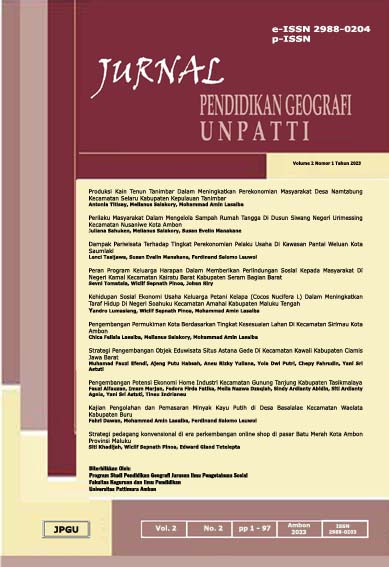Analysis of the Potential of Sago Flour Processing (Metroxylon) in Supporting the Sago Bioindustry (Waraka Sago) in Waraka Village, Central Maluku Regency
Analisis Potensi Olahan Tepung Sagu (Metroxylon) Dalam Mendukung Bioindustri Sawa (Sagu Waraka) di Negeri Waraka Kabupaten Maluku Tengah
Abstract
Waraka Country is one of the sago-producing countries in Maluku Province, especially Central Maluku Regency. The potential of sago that can be developed optimally is sago starch. Bioindustry is an effort made to manage agricultural and natural resources such as sago management, which is carried out with the help of technology to produce various products that have high economic value and can help the economy of sago farmers. The type of research used is descriptive qualitative; the variable in this study is a single variable. Waraka is one country with the potential for sago, which can be developed and appropriately utilised to increase income, meet the community's needs, and create the SAWA bioindustry. The processed products of sago flour in the SAWA bioindustry are refined Sago Flour, Sago Noodles, and Sago Rice. There are 2 Stages of the Sago Flour Production Process to support the SAWA (Sago Waraka) bioindustry in Negeri Waraka, Central Maluku Regency, namely the wet sago production process and the sago flour production process by SAWA bioindustry. The SAWA bioindustry (Sagu Waraka) needs sago flour to produce damp sago flour from sago producers every time they produce 200-220 sacks. The SAWA bioindustry needs wet sago flour from 30-35 sacks from the producers to the SAWA bioindustry (Sagu Waraka).
Downloads
References
Alip Suroto, D. P. E. H. S. (2023). analisis bibliometrik pemanfaatan sagu dalam pengolahan makanan. urnal Inovasi Penelitian, 3(8), 7455-7466. https://doi.org/10.47492/jip.v3i8.2481.
Ibrahim dan Hartona, 2015. (2015). Dampak kebijakan konversi lahan sagu sebagai upaya mendukung Program Pengembangan Padi Sawah di Kabupaten Halmahera Barat , Maluku Utara. 1, 1064–1074. https://doi.org/10.13057/psnmbi/m010517
Leuwol, F. S., Salampessy, M., & Dewi, W. A. (2023). Analysis of the Application of WFH Policies in Overcoming Pollution Problems in Jakarta. Riwayat: Educational Journal of History and Humanities, 6(3), 1400–1404. https://doi.org/https://doi.org/10.24815/jr.v6i3.33939
Nanlohy, L. H., & Gafur, M. A. A. (2020). Potensi Pati Sagu Dan Pendapatan Masyarakat. Median, 12(1), 21–27. http://doi.org/md.v12i1.211
Yohanes, L., Timisela, N. R., & Luhukay, J. M. (2019). Analisis Margin Pemasaran Produk Sagu (Studi Kasus Bioindustri Sawa) Di Negeri Waraka Kabupaten Maluku Tengah. AGRILAN : Jurnal Agribisnis Kepulauan ANALISIS, 9(1) 32–44.














